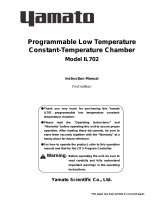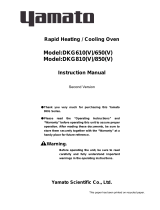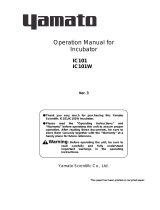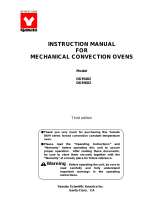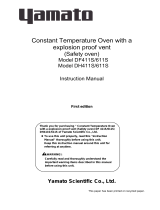
Forced Convection Constant
Temperature Oven
Model: DNE650/670/850
Model: DNE650V/670V/850V
Instruction Manual
Second edition
● Thank you very much for purchasing this Yamato
Forced Convection Constant Temperature Oven DNE
Series.
● Please read the “Operating Instructions” and
“Warranty” before operating this unit to assure proper
operation. After reading these documents, be sure to
store them securely together with the “Warranty” at a
handy place for future reference.
● For how to operate the product, refer to this operation
manual and that for the CR 5 Program Controller.
Warning: Before operating the unit, be sure to
read carefully and fully understand
important warnings in the operating
instructions.
Yamato Scientific Co., Ltd.
This paper has been printed on recycled paper.

Contents
1. Safety precautions.................................................................. 1
Explanation of pictograms ............................................................. 1
List of symbols ....................................................................... 2
Warning・Cautions ................................................................... 3
2. Before operating the unit ............................................................ 4
Precautions when installing the unit ..................................................... 4
Installation procedures/precautions...................................................... 9
3. Names and functions of parts....................................................... 10
Main unit ........................................................................... 10
Operation panel ..................................................................... 12
4. Operating procedures.............................................................. 14
Operation modes and lists of functions.................................................. 14
Overheat protector settings ........................................................... 16
Useful functions (Temperature output) .................................................. 17
Useful functions (RS485 communication function) ........................................ 19
5. Cautions on handling .............................................................. 33
6. Maintenance procedures ........................................................... 35
Daily inspection/maintenance.......................................................... 35
7. When the unit is not to be used for a long time or when disposing...................... 36
When the unit is not to be used for a long time or when disposing........................... 36
Notes about disposition............................................................... 36
8. Troubleshooting................................................................... 37
Safety device and error codes ......................................................... 37
When a malfunction is suspected ...................................................... 38
9. After sales service and warranty .................................................... 39
When requesting a repair ............................................................. 39
10. Specifications.................................................................... 40
11. Wiring diagram ................................................................... 41
12. Replacement parts list ............................................................ 44
13. List of dangerous materials........................................................ 46
14. Standard installation manual....................................................... 47

1
1. Safety precautions
Explanation of pictograms
About pictograms
A
variety of pictograms are indicated in this operating instruction and on
products for safe operation. Possible results from improper operation
ignoring them are as follows.
Be sure to fully understand the descriptions below before proceeding to the
text.
Warning
Caution
Indicates a situation which may result in minor injury (Note 2) and
property damages (Note 3.)
(
Note 1
)
Serious injury means a wound, an electrical shock, a bone fracture or intoxication that ma
y
leave after effects or require hospitalization or outpatient visits for a long time.
(
Note 2
)
Minor injury means a wound or an electrical shock that does not require hospitalization o
r
outpatient visits for a long time.
(
Note 3
)
Property damage means damage to facilities, devices and buildings or other properties.
Meanings of pictograms
This pictogram indicates a matter that encourages the user to adhere to warning
(“caution” included).
Specific description of warning is indicated near this pictogram.
This pictogram indicates prohibitions
Specific prohibition is indicated near this pictogram.
This pictogram indicates matters that the user must perform
Specific instruction is indicated near this pictogram.
Indicates a situation which may result in death or serious injury (Note 1.)

2
1. Safety precautions
List of symbols
Warning
General warnings
Danger!: High
voltage
Danger!: High
temperature
Danger!: Moving
part
Danger!: Hazard
of explosion
Caution
General cautions Electrical shock! Burning!
Caution for no
liquid heating!
Caution for water
leak!
For water only
Poisonous
material
Prohibitions
General bans Fire ban
Do not
disassemble
Do not touch
Compulsions
General
compulsions
Connect ground
wire
Install levelly
Pull out the power
plug
Regular
inspection

3
1. Safety precautions
Warning・Cautions
Warning
Never operate the unit in an atmosphere containing flammable or explosive gas
Never operate the unit in an atmosphere containing flammable or explosive gas.
Otherwise, an explosion or a fire may result since the unit is not explosion-proof.
See section “13. List of dangerous materials” on page45.
Be sure to connect the ground wire.
Be sure to connect the ground wire correctly. Otherwise, electrical leak may result and cause an
electrical shock or a fire.
Ban on operation when an abnormality occurs
When a smoke or an unusual odor is seen or sensed, immediately turn the ELB on the main unit
off and pull out the power plug. A fire or an electrical shock may result.
Never use electrical power cords bundled.
When these are used bundled, they might overheat causing a fire.
Take care not to damage electrical power cords.
Avoid tightly bend, pull with a strong force or twist to prevent electrical power cords from
damaging. A fire or an electrical shock may result.
Never use an explosive or a flammable material with this unit.
Never use an explosive material, a flammable material or a material containing them. An
explosion or an electrical shock may result.
See section “13. List of dangerous materials” on page 45.
Never try to touch a hot part.
Some parts of the unit are hot during and immediately after operation. Take special care for
possible burning.
Never try to disassemble or alter the unit.
Never try to disassemble or alter the unit. A malfunction, a fire or an electrical shock may result.
Caution
When a thunder is heard.
When a thunder is heard, turn the main power off immediately. A malfunction, fire or an electrical
shock may result.

4
2. Before operating the unit
Precautions when installing the unit
1. Carefully select an installation site.
Take special care not to install the unit at a place described below:
・ Uneven surfaces or dirty surfaces
・ Where flammable gas or corrosive gas exists
・ Where the ambient temperature is 35℃ or more
・ Where temperature changes severely
・ Where humidity is high
・ Where subject to direct sunlight
・ Where vibration is severe
Install this unit at a place with spaces shown below.
2. Install the unit on a level surface.
Install the unit on a level surface. If the whole bottom surface of the unit does not contact the
surface evenly, vibrations or noises may result. This might cause unexpected troubles or
malfunctions.
The unit weight: DNE650 (V)/670 (V):Approx.90 ㎏、DNE850 (V):Approx.130 ㎏
When lifting the unit for transportation and installation, carefully handle it by at least two
people.
3. Installation
The unit might fall down or move by an earthquake or an impact resulting a personal injury.
We recommend making safety measures such as to avoid installing the unit at a place other
than busy places.
Main
Body
50 ㎝ or more
20 ㎝ or more 50 ㎝ or more
80 ㎝ or more

5
2. Before operating the unit
Precautions when installing the unit
4. Secure sufficient ventilation for the unit.
Do not operate the unit when suction port and heat radiation port on the side and rear panels
are blocked.
Internal temperature of the unit will rise degrading the performance and an accident, a
malfunction or a fire may result.
5. Do not operate the unit at such a place that may subject to splash.
Do not operate the unit at such a place that may subject to splash. Liquid entering the inside
may cause an accident, a malfunction, an electrical shock or a fire.
6. Never operate the unit in an atmosphere containing flammable or explosive gas.
Never operate the unit in an atmosphere containing flammable or explosive gas. Since the
unit is not explosion-proof, an arc is discharged when switching the ELB “ON” and “OFF” and
during operation and a fire or an explosion may result.
See the section “13. List of dangerous materials” on page 46 for flammable and explosive
gases.
Ex
p
losive Gas
Flammable Gas

6
2. Before operating the unit
Precautions when installing the unit
7. Be sure to connect the power plug to the dedicated power distribution panel or
a wall outlet.
Use a power distribution panel or a wall outlet that meets the electrical capacity of the unit.
Electrical
capacity:
DNE650(V) AC100V-120V 14~16.5A
DNE670(V) AC200V-240V 7~8.5A
DNE850(V) AC200V-240V 12.5~15A
* When the unit will not start even when you turn the Electric Leakage Breaker to “ON”, check
for low main voltage or if the unit is connected to the same power supply line as other devices
and connect it to another line if necessary.
Avoid connecting too many devices using a branching outlet or extending a wire with a cord reel
or heating function and temperature controlling function may degrade due to voltage drop.
Do not connect the unit to any parts or lines other than a correct power supply line such as a
gas pipe, a water pipe or a telephone line.
Otherwise, an accident or a malfunction may result.
8. Handling of a power cord
Never use electrical power cords bundled. When these are used bundled, they might
overheat causing a fire.
Do not convert, forcibly bend, twist or pull the power cord. Otherwise, a fire or an electrical
shock may result.
Do not place the power cord under a desk or a chair, or sand between objects to avoid it
from being damaged.
Otherwise, a fire or an electrical shock may result.
Do not place the power cord close to a stove or other heat generating device. Sheath of the
cord may burn and result in a fire or an electrical shock.
If the power cord should be damaged (exposure of core wire or disconnection), immediately
turn the ELB off, turn the power supply off and ask your dealer to replace the cord. If the
unit is operated with a damaged power cord, a fire or an electrical shock may result.
Connect the power cord to an appropriate wall outlet or distribution board.
9. Be sure to connect the ground wire.
・ When the unit has no ground terminal, class D grounding work is necessary and please
consult your dealer or our nearest sales office.
・ Securely connect to an outlet.
The unit does not have a power plug. Connect
the earth correctly to suit the power facility to
be connected.
Do not connect the grounding wire to any parts or lines other than a correct grounding
terminal such as a gas pipe, a water pipe or a telephone line.
Otherwise, an accident or a malfunction may result.
M5 round
terminal
Green
(
to eart
h
terminal
)
Bl
ac
k(
to rate
d
power
terminal
)
Whi
te
(
to rate
d
power
terminal)

7
2. Before operating the unit
Precautions when installing the unit
10. Be careful for the colors of core wires when connecting the power cords.
Be sure to first make sure that the breaker on the power
facility side is “Off” before connecting the power cords.
The unit does not have a power plug. Select and connect
a plug and a terminal with correct ratings suited to the
power source capacity of the power facility to be
connected. (See the table in the right)
Core wire
color
Indoor wiring
Black Voltage side
White Earth side
Green Earth
11. .Do not attempt to alter the unit 12. Do not put too many specimens.
The customer shall never attempt to alter
the unit. Otherwise a malfunction may
result.
Modification
The withstand load of a shelf board is
15kg when the load is evenly distributed.
Put specimens dispersed.
Specimen
15kg
Shelf board
13. Do not set too many specimens. 14. Do not place an object on the
bottom plate.
Too many specimens will prevent correct
temperature control. In order to assure
temperature precision, be sure to use shelf
boards and put specimens dispersed, and
secure at least 30% of space inside the
bath.
Secure at least 30% of space
Operating the unit with placing the
specimen directly on the bottom plate of the
internal bath will prevent performance of
the product from fully exerting, increase the
internal temperature excessively and may
cause a malfunction.
Never place a specimen on the bottom
plate of the internal bath.

8
2. Before operating the unit
Precautions when installing the unit
15. Placing shelf boards and specimens
Shapes of shelf boards will differ depending on the model and each model contains two to
four boards.
One of them has been fixed on the lowest stage of the shelf peg pillars inside the unit with
screws at the time of factory shipping.
Set the remaining shelf boards to appropriate positions in the unit.
One of the shelf boards has been
fixed on the lowest stage of the shelf
peg pillars inside the unit with screws
at the time of factory shipping.
A heater and a fan are installed under
the rectifier plate. And temperature of
the rectifier plate and around it is
always higher than the set
temperature and if you place a
specimen directly on the plate, it may
burn or a fire may result.
Slit at the front side of the rectifier
plate is the suction slit of the hot air
convection route. Never block this slit
with a specimen or other objects.
For this reason, the shelf boards are
held with screws as shown in the
drawing to prevent specimens from
being placed directly.
If you need to remove shelf boards
due to the shape of a specimen to
set, secure sufficient space to the
rectifier plate and never place the
specimen directly.
16. About handling of the exhaust port
Open the suction port at the lower part of the right side of the main unit when you want to use
the exhaust port at the ceiling of the main unit (rear side for DNE850/850V). Take special
care for burning when operating the air suction and exhaust ports become hot because they
will become hot.
17. About handling of specimens
Forced convection is performed to assure proper temperature distribution in the bath. Make
sure that specimen will not fly when processing powder or small specimens. A fire or an
electrical shock may result if a flammable object or a metal part is dropped in the heater
assembly.
It might take time for temperature to increase when the amount of specimens is considerable
or when processing a specimen of larger heat load. Check the appropriate amount of
specimens as necessary before setting them.
Also note that the displayed temperature may become unstable when processing a
heat-producing specimen (limited to those are free of its explosion, firing, or ignition).
Shelf pilla
r
Rectifying
board
Shelf peg
Screw
Screw
Shelf board

9
Precautions when installing the unit
Installation procedures/precautions
(1)
Release the stopper lock of the caster wheels.
Set the stoppers of the caster wheels to the
high position as shown in the drawing in the
right.
Now the lock is released.
(Only two caster wheels at the front of the
unit have stoppers.)
キャスター
ストッパー
ロック
ロック解除
(2) Transport the unit to the installation site.
*Transporting the unit over a gap may give an excessive shock to the caster wheels and may
damage them.
If such trouble is expected, lift the unit and transport it over the gap.
(3) Lock the caster stoppers when the unit has been transported to the installation site.
They are locked.
(4) Connection of the power supply.
Make sure that the ELB is “OFF” before connecting the power supply to the power distribution
board and the outlet.
Set the power voltage selector switch.
Set the power supply voltage selector switch at the rear of the main unit to the power supply
voltage to be used.
(5)
Model DNE650/650V
・For 100~110V ・For 115~120V
100~110V 115~120V 100~110V 115~120V
Model DNE650/650V
・For 100~110V ・For 115~120V
100~110V 115~120V 100~110V 115~120V
(6) Set the power supply voltage of the controller.
Turn the ELB “ON” and set the power supply voltage of the controller to the power supply
voltage to use.
The voltage is set at 100V for the model DNE650/650V and 200V for the models
DNE670/670V/DNE850/850V at the time of factory shipping.
Refer to “2. Power supply voltage setting” on P.45 of the separate “Operation manual for the
Program Controller model CR5” for how to make settings.
Lock release
Lock
Stopper
Caster

10
3. Names and functions of parts
Main unit
Front side of DNE650(V)/670(V)
Rear side of DNE650(V)/670(V)
Exhaust port
Cable port
Suction port
Shelf board
ELB
Overheat
preventive
device
Operation panel
Door
Handle
Rating sticker
Sensor access port
Manual holder
External output
terminal
Power supply voltage
selector switch
Temperature fuse
access port
Power cord

11
3. Names and functions of parts
Main unit
Front side of DNE850(V)
Rear side of DNE850(V)
Overheat preventive
device
Operation panel
Door
Handle
ELB
Cable port
Shelf board
Suction port
Caster wheels at four points
(Two front wheels have a
lock)
Power supply voltage
selector switch
External output
terminal
Sensor access port
Manual holder
Exhaust port
Temperature fuse
access port
Power cord
Rating sticker

12
3. Names and functions of parts
Operation panel
FIXED TEMP.
PAUSE
AUTO
START
AUTO
STOP
PROGRAM
PAUSE
TEMP.SET TIME SET ENTER CANCEL
TIMER
SET TEMP.
℃
MEASURED TEMP.
HR MIN.
HEATER
TIME
CLOCK
CLOSED
TIME
RUN
STOP
RETURN 2SEC.
POWER
SETSTEP
3~2
PROGRAM
1
GUIDE
FUNCTION
1・2
KEY
LOCK
F2→2SEC.
PROGRAM PROGRAM
PROGRAM REPERT
NO. Name Operation/action
①
HEATER lamp Lights when the heater is turned on.
②
HOUR lamp Lights when the timer is set in hours.
③
TIME lamp Lights when the timer is set in clock time.
④
REMAINING HOUR lamp Lights when the Timer screen displays the remaining operation time.
⑤
RUN/STOP key The key is used to start/stop specific operation.
⑥
POWER key The key is used to turn on or off the power to the controller.
⑦
PROGRAM key The key is used to select program operation.
⑧
AUTO STOP key The key is used to select auto stop operation.
⑨
AUTO START key The key is used to select auto start operation.
⑩
FIXED TEMP key The key is used to select fixed temperature operation.
⑪
Measured Temperature Display
Screen
The screen displays the measured temperature and error numbers.
⑫
Operation Guide Screen The screen describes status.
⑬
Set Temperature Display Screen The screen displays the set temperature and parameter settings.
⑭
Timer Display Screen The screen displays the set time and the remaining hours.
⑮
HOUR UNIT lamp The lamp comes on when the time setting is the hour.
⑯ MIN UNIT lamp The lamp comes on when the time setting is the minute.
⑰
TEMP. SETkey The key is used to set or change temperature for the fixed temperature
operation or program operation.
⑱ TIME SET key
The key is used to set or change time for the fixed temperature operation
or program operation.
⑯
②
③
④
⑤
⑥
①
⑮
⑭
⑬
⑦
⑧
⑨
⑩
⑪
⑫
⑱
⑰

13
3. Names and functions of parts
Operation panel
FIXED TEMP.
PAUSE
AUTO
START
AUTO
STOP
PROGRAM
PAUSE
TEMP.SET TIME SET ENTER CANCEL
TIMER
SET TEMP.
℃
MEASURED TEMP.
HR MIN.
HEATER
TIME
CLOCK
CLOSED
TIME
RUN
STOP
RETURN 2SEC.
POWER
SETSTEP
3~2
PROGRAM
1
GUIDE
FUNCTION
1・2
KEY
LOCK
F2→2SEC.
PROGRAM PROGRAM
PROGRAM REPERT
No.
Name Operation/action
①
CANCEL key The key is used to go back to the previous parameter item or to clear
parameter settings.
②
ENTER key The key is used to advance to the next parameter item or to determine a
parameter setting.
③
Repeat Display Screen The screen displays repeat setting and the number of repetitions.
④
REPEAT SET key The key is used to set repeat during program operation.
⑤
Step Display Screen The screen displays the selected step and steps to be executed.
⑥
STEP key The key is used to set steps for program operation.
⑦
PROGRAM 3 key The key is used to select program 3.
⑧
PROGRAM 2 key The key is used to select program 2.
⑨
PROGRAM 1 key The key is used to select program 1.
⑩
LOCK key The key is used to lock settings.
⑪
FUNCTION 1/2 key The key is used to set various functions of the controller.
⑫
GUIDE key The key is used to show guidance on the Operation Guide screen.
⑬
DIGIT SHIFT key The key is used to shift a digit during setting.
⑭
▼▲ keys The keys are used to increase/decrease settings.
①
②
⑭
⑬
③
④
⑤
⑥
⑨
⑫
⑪
⑩
⑧
⑦

14
4. Operating procedures
Operation modes and lists of functions
There are six operation modes as shown below.
Refer to the separate “Operation Manual for the model CR5 Program Controller” for details.
№
Name Function
1 Fixed Temp. operation Controls temperature at a constant temperature.
2 Auto Stop operation Stops operation at a set time.
3 Quick Auto Stop operation
Allows setting auto stop operation during fixed temperature
operation.
4 Auto Start operation Starts operation at a set time.
5 Program operation Performs program operation.
6 Program Auto Start operation Starts program operation at a set time.
The function menu shows the following 16 functions (including when optional devices are installed).
Refer to the separate “Operation Manual for the model CR5 Program Controller” for details.
№
Name Function
Functions of FUNCTION 1
1
Display language setting
This function is used to select Japanese or English as
the display language.
2
Power supply voltage setting
This function is used to select the power supply voltage
to use.
3
Calendar/Time setting
You can set the dominical year, month, date and the
current time.
4
Time/Hour selection
You can select whether timer operation will be set in
hours or in time.
5
Buzzer setting
You can turn on or off sound of key operation, time up,
operation disabled and door open separately.
6
Heater output operation level display
The heater output level in % can be continuously
monitored.
7
Electricity/electric power charge
display
You can monitor the basic unit for electric power charge
calculation, electric power volume and charge for
various units from an hour to a year, total electric power
charge, electric power volume and charge for one cycle
operation.
Functions of FUNCTION 2
8
Motor output setting
This function is used to set rotation and stop of the fan
motor.
9
Calibration offset setting
The function is used to compensate a calibration offset
temperature.
10
External communication setting
The function is used to set conditions for external
communication.
11
Power failure compensation function
setting
The function enables you to set whether to continue or
hold the operation after recovery from a power failure.
12
Wait function setting
The function is used to set a wait zone and a wait time.
This setting may not be different among different steps.
13
Accumulated time display
The display allows monitoring of accumulated time of
operation of the controller (unit).
14
Warning history display
The display allows monitoring of error information of 20
incidents in the past.

15
4. Operating procedures
Operation modes and lists of functions
Refer to the separate “Operation Manual for the Model CR5 Program Controller” for details of
operations.
No. Operations
Corresponding page in the operation
manual for the model CR5 Program
Controller.
1 Description of the Control Panel P.1
2 Fixed Temperature Operation P.10
3 Fixed Temperature Auto Stop Operation P.11
4
Fixed Temperature Quick Auto Stop
Operation
P.12
5 Fixed Temperature Auto Start Operation P.13
6 Program Operation P.14
7 Program Auto Start Operation P.34
8 Program Step change Function P.35
9 Lock Settings P.40
10 Guide Function P.42
11 Suspension Function P.43
12
Program Pattern Registration Function
P.28
13 Program Pattern Assignment Function P.25
14 Settings of FUNCTION 1 P.44
15 Settings of FUNCTION 2 P.52

16
4. Operating procedures
Overheat protector settings
The stand-alone overheat protector consists of a temperature measurement circuit, CPU, sensors,
and the output circuit separate from the controller. When the protector is activated, the unit will stop
and will not recover until the earth leakage breaker is turned on again. (Manual recovery)
Temperature setting for the stand-alone
overheat protector
270
℃
① Set the temperature with the ▼▲ keys.
About the stand-alone overheat protector
When the difference in the set temperatures between the stand-alone overheat
protector and the controller is small, the protector may be activated and operation
may be stopped. Set the temperature for the protector at least 10℃ higher than that
for the controller. Note that the protector is not available for the purpose of
protecting specimens.
The temperature is set at 270℃ at the time of shipping.
If you want to operate the stand-alone overheat protector at a temperature you want,
first operate the unit with the temperature in the bath at that setting until operation
becomes stable, then gradually lower the protector setting and make sure that it
operates reliably at the temperature setting you want. It takes about five seconds
before it starts operation for which time you have to wait before checking. When the
protector is triggered, it displays Er07 and operation stops. Since the activation
temperature for the sensor of the protector differs depending on overshoot at the
time of heating or specimen status, set it at as high temperature as possible.
Also, when the protector set temperature has been changed, wait for about five
seconds until that temperature is recorded before turning power off.

17
4. Operating procedures
Useful functions (Temperature output)
Before operating the unit
Be sure to follow instructions in this manual for operating the product. Operations other
than those specified in this manual may cause a trouble. Also take care that the warranty
may be void if any operation other than those specified in this manual is performed.
CAUTION
1. Be sure to turn the breaker OFF before making any connections. (Refer to P.18))
2. Be sure to use the unit at or below the rated capacity when you use the alarm output
and the time-up output.
3. Make any connection secure with the screws attached to the terminal block.
Connecting procedures
Securely connect to the terminal to be used.
The alarm output and the time-up output are “ON” (relay contact closed) at the time of
outputting.
When temperature output is used, use a shielded cable to prevent noises.
ALARM SIGNAL
COM NO COM NO
TIME UP
+-
TEMP
A+ A-
RS-485
External Alarm Output
Temp.1~5V
(0~320℃)
Connecting terminals

18
4. Operating procedures
Useful functions (Temperature output)
Specifications
Temperature output
(ANALOG)
• Outputs a voltage (DC) according to the measured temperature
• Output temperature range:0~320℃
• Output voltage :DC1~5V
• Resolution :±1.6℃
• Connection :M4 screw terminal block
Alarm output
(ALARM)
• Outputs when an abnormality is detected (For description of
abnormalities, see “Safety device and error codes” on P.37.)
• A-contact (relay contact)
• Contact capacity : AC250V 3A (resistance load)
DC30V 3A (resistance load)
• Connection : M4 screw terminal block
Time up output
(TIME UP)
• Outputs on time-up of AUTO STOP, AUTO START or QUICK
AUTO STOP or at program end.
• A-contact(relay contact)
• Contact capacity : AC250V 3A(resistance load)
DC30V 3A(resistance load)
• Connection : M4 screw terminal block
Temperature output(ANALOG)
Temperature(℃) Output voltage(V)
0 1.00
20 1.25
40 1.50
60 1.75
80 2.00
100 2.25
120 2.50
140 2.75
160 3.00
180 3.25
200 3.50
220 3.75
240 4.00
260 4.25
280 4.50
300 4.75
320 5.00
Page is loading ...
Page is loading ...
Page is loading ...
Page is loading ...
Page is loading ...
Page is loading ...
Page is loading ...
Page is loading ...
Page is loading ...
Page is loading ...
Page is loading ...
Page is loading ...
Page is loading ...
Page is loading ...
Page is loading ...
Page is loading ...
Page is loading ...
Page is loading ...
Page is loading ...
Page is loading ...
Page is loading ...
Page is loading ...
Page is loading ...
Page is loading ...
Page is loading ...
Page is loading ...
Page is loading ...
Page is loading ...
Page is loading ...
Page is loading ...
/

